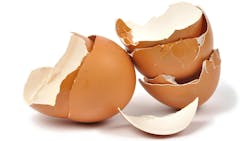Eggshells in dentistry? The potential of eggshell hydroxyapatite
Every year, millions of tons of eggshells are discarded globally, mostly from households and the food industry. Often viewed as kitchen waste, these fragile shells harbor remarkable potential. Through scientific innovation, this abundant byproduct is being transformed into hydroxyapatite (HAp), a valuable biomaterial with unique properties and wide-ranging applications, especially in medicine, dentistry, and environmental science.
Hydroxyapatite (Ca₁₀(PO₄)₆(OH)₂) is the principal inorganic component of bones and teeth in vertebrates, comprising roughly 70% of bone mass and more than 90% of tooth enamel. Because it is already a natural part of the human body, synthetic HAp offers excellent biocompatibility, integrating into living tissues with minimal risk of rejection or inflammation.
Chicken eggshells, often discarded without a second thought, are surprisingly rich in calcium, composed of approximately 94%–97% calcium carbonate (CaCO₃), primarily in the form of calcite. They also contain small amounts of magnesium carbonate, calcium phosphate, and organic matter. Thanks to this high calcium content, eggshells offer a sustainable, low-cost, and readily available raw material for synthesizing calcium-based compounds such as hydroxyapatite.
The nano-sized form of hydroxyapatite (nHAp), especially when derived from eggshells, holds particular promise. These particles typically range from 20 to 50 nms, giving them a larger surface area and greater bioactivity than larger particles and making them quite effective in medical and dental applications.
However, pharmaceutical-grade eggshell nHAp remains relatively rare, and only a few manufacturers are currently harnessing its potential. Unlocking the power of this natural byproduct could bring both environmental and economic benefits, transforming waste into a valuable resource for regenerative technologies.
How to develop eggshells into a beneficial aid
Several chemical synthesis methods have been developed to convert eggshell-derived calcium carbonate into hydroxyapatite. Each technique offers different benefits depending on the desired properties of the final product, such as crystallinity, particle size, and porosity.
One of the most widely used methods is wet chemical precipitation. This begins by cleaning and pulverizing the eggshells, which are then calcined—heated at high temperatures—to convert the calcium carbonate into calcium oxide (CaO). This CaO is then reacted with a phosphate source, such as phosphoric acid or ammonium phosphate, under controlled pH and temperature conditions. Hydroxyapatite precipitates from the solution and is subsequently filtered, washed, and dried. This process is straightforward, cost-effective, and scalable, making it more ideal for production. In fact, synthetic nHAp is typically produced via this precipitation method in laboratory settings.
Another technique is the hydrothermal method, which involves reacting the calcium source with phosphate in a sealed, high-pressure vessel. The elevated temperature and pressure conditions help produce highly crystalline hydroxyapatite, making this method particularly suitable for medical-grade materials where purity is paramount. A 2023 study by Wu et al. demonstrated the effectiveness of both precipitation and hydrothermal synthesis methods using eggshells as the calcium source, showing promising biomedical applications for the resulting nano-hydroxyapatite.1
A third technique, the Sol-Gel process, involves forming a homogeneous "sol" from calcium and phosphate precursors. As the sol transitions into a gel, it undergoes heat treatment to form crystalline hydroxyapatite. This method offers precise control over composition and structure, making it ideal for applications requiring nanoscale uniformity. Each synthesis pathway has its advantages and trade-offs, but all share a common goal: turning an agricultural waste product into a scientifically valuable material.
How eggshells can be used in dentistry
In dentistry, eggshell-derived HAp is showing significant promise.2 Biocompatibility coupled with the structural similarities to natural teeth make it supreme for use in remineralizing toothpaste, where it helps restore enamel, reduce sensitivity, and even support whitening.3 A study concluded that eggshell powder and nHA are affected in mitigating the adverse effects of bleaching on enamel, with eggshell showing a slightly superior performance in enhancing micro hardness.4
The nano-hydroxyapatite derived from eggshells is considered premium because it not only closely mimics enamel but also contains essential trace elements such as magnesium and zinc, which improve calcium absorption and overall performance. When paired with ingredients like xylitol, the result is an effective, bioactive toothpaste with broad appeal.
Beyond toothpaste, HAp is used as a coating on dental implants to improve their integration with the surrounding bone, enhancing implant longevity. It can also serve as a filler in bone grafts, promoting regeneration by providing a scaffold that supports new bone growth, a process known as osteoconduction.5 Porous HAp structures can be loaded with drugs or therapeutic agents, allowing for controlled release directly at the target site, such as within bone or dental tissues.
Eggshells for the environment
But eggshell-derived HAp is not limited to dental and orthopedic applications. The unique chemical and structural properties make it effective in environmental applications as well. HAp can absorb heavy metal ions such as lead, cadmium, and chromium from contaminated water. It also has the potential to be used as a catalyst, in chromatography, and in various sensing technologies. These capabilities make it an exciting candidate for sustainable water treatment and pollution control.
Scientific studies continue to support the safety and effectiveness of eggshell-derived nHAp. A 2024 study by Al Bayaty et al. found that eggshell-based nHAp exhibited no toxicity toward human osteoblasts (bone-forming cells) or fibroblasts (connective tissue cells), and even enhanced their viability.6 Another current study highlighted the potential of using sustainable sources like fish scales and poultry eggshells for HAp production, emphasizing the material’s promise in dental care.7
While challenges remain, particularly in scaling production and meeting stringent regulatory requirements for medical use, the momentum is building. Researchers are working to refine synthesis techniques, customize HAp properties for specific applications, and increase industrial output without sacrificing quality.
The transformation of humble eggshells into advanced hydroxyapatite represents a powerful intersection of materials science, environmental consciousness, and biomedical innovation. What was once bound for the landfill now offers the potential to heal bones, protect teeth, purify water, and promote a more sustainable future. It’s a reminder that sometimes, cracking an egg is just the beginning.
References
- Wu SC, Hsu HC, Wang HF, Liou SP, Ho WF. Synthesis and characterization of nano-hydroxyapatite obtained from eggshell via the hydrothermal process and the precipitation method. Molecules. 2023;28(13):4926. doi:10.3390/molecules28134926
- Pepla E, Besharat LK, Palaia G, Tenore G, Migliau G. Nano-hydroxyapatite and its applications in preventive, restorative and regenerative dentistry: a review of literature. Ann Stomatol (Roma). 2014;5(3):108-114.
- Mkhize SC, Onwubu SC, Mokhothu TH, Mdluli PS, Mishra AK. Comparative assessment of the remineralization characteristics of nano-hydroxyapatite extracted from fish scales and eggshells. J Appl Biomater Funct Mater. 2023;21:22808000231180390. doi:10.1177/22808000231180390
- Hassan SN, Moharam LM. Effect of eggshell powder and nano-hydroxyapatite on the surface roughness and microhardness of bleached enamel. Contemp Clin Dent. 2023;14(1):62-67. doi:10.4103/ccd.ccd_590_21
- Muthu D, Suresh Kumar G, Gowri M, et al. Rapid synthesis of eggshell derived hydroxyapatite with nanoscale characteristics for biomedical applications. Ceramics Int. 2022;48(1):1326-1339. doi:10.1016/j.ceramint.2021.09.247
- Al Bayaty F, Al-Obaidi MMJ, Lokman A, Yazid S, Ibrahim OE. Osteoconductive properties of synthetic eggshell hydroxyapatite: an experimental study in rats. Arab Gulf J Sci Res. 2024;42(4):1491-1503. doi:10.1108/AGJSR-04-2023-0155
- Meenakshi SV, Muthupriya P, Kanchana G, et al. Fish scale and eggshell conversion into hydroxyapatite: a route to dentistry treatment. Appl Phys. 2024;130:434. doi:10.1007/s00339-024-07597-2
About the Author

Anne O. Rice, BS, RDH, CDP, FAAOSH
Anne O. Rice, BS, RDH, CDP, FAAOSH, founded Oral Systemic Seminars after over 35 years of clinical practice and is passionate about educating the community on modifiable risk factors for dementia and their relationship to dentistry. She is a certified dementia practitioner, a longevity specialist, a fellow with AAOSH, and has consulted for Weill Cornell Alzheimer’s Prevention Clinic, FAU, and Atria Institute. Reach out to Anne at anneorice.com.

